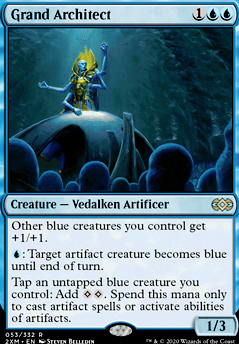Creature (16)
-
3x
Drift of Phantasms

-
4x
Grand Architect

-
1x
Hangarback Walker

-
3x
Myr Superion

- 4x Pili-Pala
- 1x Trinket Mage
Planeswalker (2)
Land (20)
-
2x
Academy Ruins

-
1x
Breeding Pool

- 1x Darksteel Citadel
-
4x
Flooded Strand

-
2x
Hallowed Fountain

- 3x Island
- 1x Plains
-
3x
Polluted Delta

- 1x Polluted Delta
- 1x Swamp
-
1x
Watery Grave

Enchantment (1)
Artifact (9)
-
4x
Aether Vial

-
1x
Chalice of the Void

-
2x
Engineered Explosives

-
1x
Staff of Domination

- 1x Viridian Longbow
Instant (7)
Sorcery (5)
Sideboard
Enchantment (5)
Artifact (3)
Instant (3)
Maybeboard
Suggestions
Updates Add
Comments View Archive
Attention! Complete Comment Tutorial! This annoying message will go away once you do!
Important! Formatting tips — Comment Tutorial — markdown syntax
Please login to comment
| Top Ranked |
|
| Date added | 8 years |
| Last updated | 5 years |
| Key combos | |
| Legality | This deck is Modern legal. |
| Rarity (main - side) | 13 - 1 Mythic Rares 21 - 12 Rares 3 - 2 Uncommons 18 - 0 Commons |
| Cards | 60 |
| Avg. CMC | 1.82 |
| Tokens | Thopter 1/1 C |
| Folders | Cool Decks, Rogue Decks, Cool modern decks, Inspirational Decks, Karate, artifact decks, Dr. Modernlove, or How I Learned to Stop Netdecking and Love the Brew, Modern Decks, Build this, Yay |
| Votes | |
| Ignored suggestions | |
| Shared with | |
| Based on | |
| Views |



